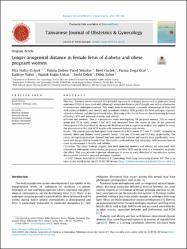Longer anogenital distance in female fetus of diabetic and obese pregnant women

Göster/
Erişim
info:eu-repo/semantics/openAccessTarih
2023Yazar
Halıcı Öztürk, FilizYetişkin, Fatma Didem Yücel
Gürlek, Beril
Öcal, Fatma Doğa
Yakut, Kadriye
Engin Üstün, Yaprak
Celen, Şevki
Şahin, Dilek
Üst veri
Tüm öğe kaydını gösterKünye
Halici-Ozturk, F., Yucel Yetiskin, F. D., Gurlek, B., Ocal, F. D., Yakut, K., Engin-Ustun, Y., Celen, S., & Sahin, D. (2023). Longer anogenital distance in female fetus of diabetic and obese pregnant women. Taiwanese journal of obstetrics & gynecology, 62(4), 530–536. https://doi.org/10.1016/j.tjog.2023.02.005Özet
Objective: Previous studies revealed that prenatal exposure to androgen excess such as polycystic ovary syndrome (PCOS) is associated with offspring's anogenital distance (AGD) length, and AGD is a biomarker of intrauterine androgen exposure. This study aims to investigate a possible relationship of fetal AGD with maternal diabetes and obesity, and to evaluate whether AGD predicts the fetal androgen exposure related to diabetes and obesity in female fetus. This study is the first to focus on the relationship between offspring's AGD and maternal diabetes and obesity.Materials and methods: This is a prospective study investigating 218 pregnant women (125 in control group and 93 in study group). Fetal AGD was measured from the center of anus to the posterior convergence of the fourchette by ultrasound. Multivariate linear regression analysis was applied to assess the association of the fetal AGD length with maternal diabetes and obesity.Results: The control patients had significantly shorter fetal AGD (mean:10.7 mm, P < 0.001) compared to diabetic, obese and diabetic obese patients (mean: 12.6 mm, 12.8 mm and 12.9 mm, respectively). The results of regression analysis showed that both maternal diabetes and obesity were significantly correlated with longer AGD in female fetus. The results confirmed also that offspring's AGD measurement in utero by ultrasound is feasible and reliable. Conclusion: The study findings suggest that both maternal diabetes and obesity are associated with intrauterine androgenic milieu during pregnancy, and fetal AGD may be used as a biomarker to predict this effect. This may provide important advantages in terms of early detection of reproductive system abnormalities related to prenatal androgen exposure

















